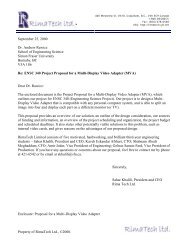Fleksibilni Internet servisi na bazi kontrole kašnjenja i
Fleksibilni Internet servisi na bazi kontrole kašnjenja i
Fleksibilni Internet servisi na bazi kontrole kašnjenja i
Create successful ePaper yourself
Turn your PDF publications into a flip-book with our unique Google optimized e-Paper software.
where wi(t) is the waiting time of the packet and si is the delay differentiation parameter<br />
of class i. Setting the delay differentiation parameter si to a larger value results in a lower<br />
delay experienced by packets in class i. It has been shown [12], [24] that average waiting<br />
time for any two classes i and j serviced by WTP satisfies:<br />
di j<br />
→ (8)<br />
d<br />
j<br />
under heavy-load conditions. Therefore, choice of delay differentiation parameters si and<br />
sj determines the ratio of average queuing delays in these two classes.<br />
Fig. 6. Traffic classes in EDS model receive asymmetric loss and delay performance.<br />
23<br />
s<br />
s<br />
i<br />
PLR dropper [24] is a packet dropping mechanism that closely approximates<br />
proportio<strong>na</strong>l loss rate differentiation between classes. PLR maintains estimates of loss<br />
rates li in each class. When an active queue ma<strong>na</strong>gement (AQM) algorithm in a router<br />
decides that a packet should be dropped, PLR selects the backlogged class with the<br />
minimum normalized loss rate li/σi, where σi is the loss differentiation parameter of class<br />
i, and drops a packet from class i. Dropping a packet from class i tends to equalize






